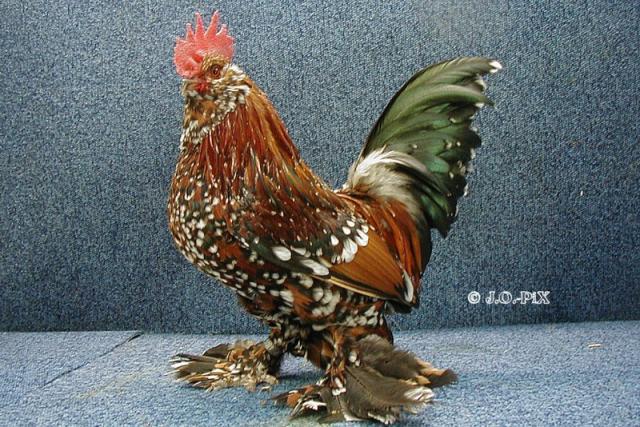I was planning to put him with my girls that have very little black. So, how do we "melanize" the the restrictors?
Melanisers & restrictors are different types of genes. It is black pigment available in the feather which affects the amount of black. The restrictor genes restrict back from being laid down in a certain area or, in combination with other pattern causing genes, cause the black pigment to be laid in a certain part of the feather, thus allowing colour pigment into areas that would otherwise not be colour. For instance the laced wyandottes, that is a combination of at least three genes. Pattern gene organises the black pigment; melanotic ( a melaniser) gives more black pigment & columbian pushes the black to the outer edge of the feather. If one or more of the pattern genes or melanotic genes are missing, the pattern changes.
There would be a few ways of getting melanisers into ones lines. Buff columbians must have melanisers to enable the heavily black hackles, so an outcross to those, & cross straigt back in, ought to help. Or outcrossing to black mottled is sure to get
lots of melanisers but also one needs to take into consideration that black mottled does not passing on any columbian genes to offspring so the other parent needs, ideally, to have two columbian genes. If the other parent does not have two columbian genes then, statistically, in the region of half of the offspring will have no columbian genes at all.
So basically even if the roo is heavy on the black on the REST of him, he shouldn't have a black mottled chest and be used for the MFC breeding program?
The likelihood is, that if the bird has a lot of black on all parts then that is probably caused by melansiers, (possibly in conjunction with lack of columbian & maybe not). But if the bird has gold or red hackles, shoulders, wing triangle etc. but is black mottled in most other parts then it is more likely to be lack of columbian.
I hope to prod Ione for some photos of the chests of some of her males.
I am trying to ascertain the significance, if any, of having some but not much red on the breast of these males with mottled black breasts.
I also have quite a few of my jubilee Orpington wannabes which seem heavily melanised; some males with almost entirely black (or blue) breasts but with some colour. As they are still reasonably young I am waiting to see what happens.








